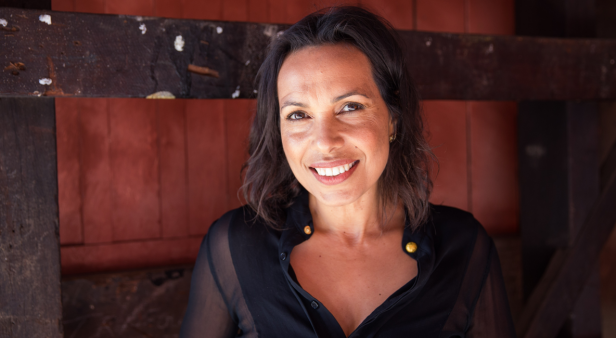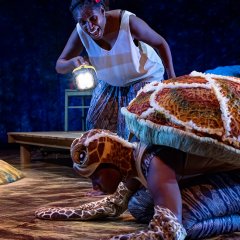We’d love to start at the beginning! Can you remember your first encounter with the world of dance and what it was that hooked you?
I remember as a five-year-old growing up in Port Augusta, South Australia and choreographing in the backyard. My father had made us a cubby house out of an old water tank and this was my stage. I dressed up my sisters and bossed them around creating an imaginary world. I had no idea that this could even be a career! It was the place where I felt most comfortable and could express myself.
What is it about the art form that you think makes it as powerful and rewarding – if not more than – other creative outlets?
Contemporary Indigenous dance is a powerful medium for transformation through story and dance. When we dance our Indigenous stories we evoke ancestral energy into our contemporary space; they sit alongside each other. For me, it communicates how we see the world – part physical, part spiritual.
Congratulations on your recent appointment of associate artistic director of Bangarra Dance Theatre! You’ve enjoyed a storied career with the company since first joining in 1993 – what were the biggest challenges you faced upon first joining Bangarra?
I think it was having the confidence to trust myself and valuing my own identity as something important to contribute to the company. Stephen Page really gave us the validation to proudly own our diversity of black experiences, even though it may reflect social and cultural displacement and trauma. At Bangarra, dance is our tool to educate and also to create the medicine to move forward.
What do you admire about the company and what it embodies as a creative entity?
I most admire that it is an urban clan that reflects the lives and experiences of black Australia, told through incredibly powerful dance theatre. It is a very disciplined company who all contribute to ensuring that the Bangarra experience embodies cultural energies, technical strength and breathtaking production elements. You find nothing like this anywhere else in the world!
You’ve created numerous works for the company during your tenure – what is your creative process in terms of creating a work from scratch?
Creating a work for Bangarra is a multi-layered process. From first concept, the next stage is undergoing the Indigenous Cultural & Intellectual Property process. This is the most important part of meeting with community and elders to speak about your idea and allow them to make decisions on what content can be used and how. This can take time so we usually allow one year from concept to realisation. Research is next, then meetings with the creative team. Rehearsals with the dancers are usually eight-to-ten weeks, then it’s in the theatre for a week bringing all the elements together before we perform to audiences.
What are the most rewarding aspects of choreographing new pieces as opposed to the thrill of dancing on stage?
I really love the lifecycle of a work. From first being inspired by a seed idea and through research and collaboration, seeing it grow to become its own entity. As a choreographer, I understand my role is to channel this and trust my process and most importantly my gut. Stories have their own way of wanting to be told and it’s up to you to listen, feel and translate this.
One of your most acclaimed works – Unaipon – will be featuring in Bangarra: 30 years of sixty five thousand. What can you tell us about how this piece was first conceptualised and what it aims to communicate to audiences?
The idea for this work first came about when my sister Gina told me about a Ngarrindjeri man who they used to call ‘Australia’s Leonardo DaVinci’. I felt shame that I knew nothing about him and frustration that we weren’t being taught about him at school. David Unaipon features on our $50 note, he was an inventor, scientist, philosopher, our first published Indigenous author and spokesperson for his people. He made so many incredible contributions that changed the way we live our lives even today. Stephen Page commissioned this work for the 2004 Adelaide Festival and we are proud to re-stage it for our 30th anniversary program.
What does the overall production hope to convey about the thousands of years of continuous Aboriginal and Torres Strait Islander culture?
The 30th program is a testament to the enduring spirit of our creative life force and commitment to the continuation of our cultural practice to storytelling through dance.
The company is celebrating 30 years of existence, which is an incredible milestone. How do you feel the performing arts industry has changed, particularly as far as visibility for Aboriginal and Torres Strait Islander creativity is concerned?
In our industry there are many amazing emerging and established Indigenous dance artists who provoke and challenge the perception of Indigeneity today. I would love to see more support, visibility and funding opportunities afforded to these artists who reflect not only the diversity of our Indigenous expressions but most importantly, ensure the continuation and growth of our art form.
Finally, what direction do you hope to take your work and that of Bangarra as a whole in future years?
When I first joined Bangarra in 1993, we were based in the PCYC in Waterloo, Sydney. The dynamic cultural/creative energy that was evident then is still inherent in the company today thanks to the vision and guidance of Stephen Page. As a company we have been through incredible highs and lows, but we understand the importance of our role as cultural ambassadors. I hope we continue to create works that celebrate our cultural expressions, that give audiences insight to our black experiences and to tell our stories powerfully, unapologetically and authentically.
Be sure to catch Bangarra Dance Theatre performing Unaipon and other works as part of Bangarra: 30 years of sixty five thousand, taking place at QPAC from August 23–31. You can purchase tickets here.


